Meet the NEW DJI Phantom 4 Pro V2 Drone
-
The new Phantom 4 Pro V2.0 features an OcuSync HD transmission system, which supports automatic dual-frequency band switching and connects to DJI Goggles RE wirelessly. Like The Phantom 4 Pro and Advanced, the Phantom 4 Pro V2.0 is equipped with a 1-inch 20-megapixel sensor capable of shooting 4K/60fps video and Burst Mode stills at 14 fps. Plus, its FlightAutonomy system includes dual rear vision sensors and infrared sensing systems for a total of 5 directions of obstacle sensing and 4 directions of obstacle avoidance. 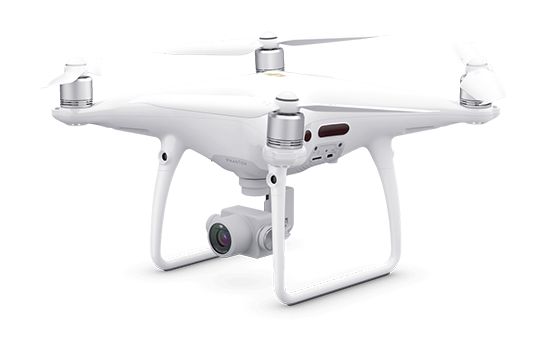

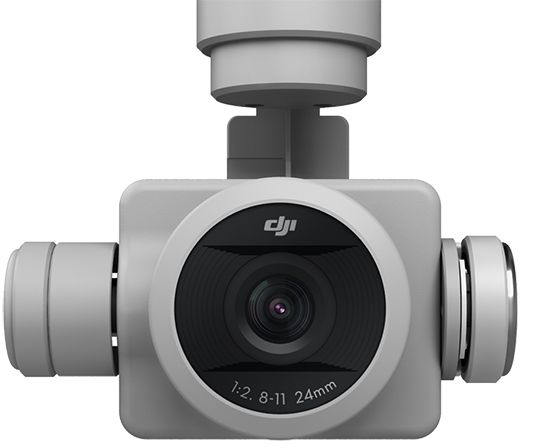
-
The onboard camera has been redesigned to use a 1-inch 20-megapixel CMOS sensor. A custom engineered lens made up of eight elements is arranged in seven groups, it is the first DJI camera to use a mechanical shutter that eliminates the rolling shutter distortion which can occur when taking images of fast-moving subjects or when flying at high speed. In effect, it is as powerful as many traditional ground cameras. More powerful video processing supports H.264 4K videos at 60fps or H.265 4K at 30fps, both with a 100Mbps bitrate. Advanced sensors and processors ensure everything is captured with more image detail and the image data needed for advanced post-production.
CAMERA WITH 1-INCH 20MP SENSOR
The Phantom 4 Pro camera system has been significantly upgraded from the Phantom 4, improving every part of the camera including, sensor size, resolution, image processing system, and more, making it the most powerful Phantom camera ever.
1-Inch 20-Megapixel CMOS Sensor
Sensor size is more important to image quality than the number of pixels because a larger sensor captures more information in every pixel, improving dynamic range, signal-to-noise ratio, and low light performance. The 1-inch 20-megapixel CMOS sensor in the Phantom 4 Pro is almost four times the size of the Phantom 4's 1/2.3in sensor. It uses larger pixels and has a maximum ISO of 12800 as well as increased contrast. It is good enough for images to be used immediately, while also capturing enough detail for advanced post-processing.

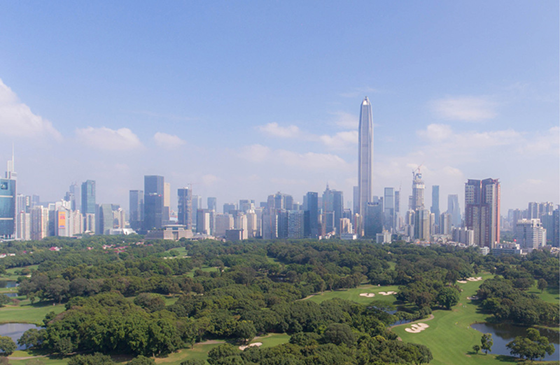 1/2.3 Inch Sensor 1/1000s F2.8 ISO 100 EV+0.1
1/2.3 Inch Sensor 1/1000s F2.8 ISO 100 EV+0.1 PHANTOM 4 PRO 1/320s F8 ISO 100 EV+0.1
PHANTOM 4 PRO 1/320s F8 ISO 100 EV+0.1 4/3 Inch Sensor 1/320s F8 ISO 100 EV+0.1
4/3 Inch Sensor 1/320s F8 ISO 100 EV+0.1 Full-Frame Sensor 1/320s F8 ISO 100 EV+0.1
Full-Frame Sensor 1/320s F8 ISO 100 EV+0.1
PRODUCTION OPTIMIZED 4K
An enhanced video processing system allows video to be captured in cinema and production optimized DCI 4K/60 (4096 x 2160/60fps) at a bitrate of 100Mbps, enabling you to get high-resolution slow-motion shots. The Phantom 4 Pro also supports the H.265 video codec (Maximum resolution 4096X2160/30fps). For a given bitrate, H.265 doubles the amount of image processing as H.264, resulting in significantly enhanced image quality. Record in the high dynamic range D-log mode to make the most of this image data for colour grading.
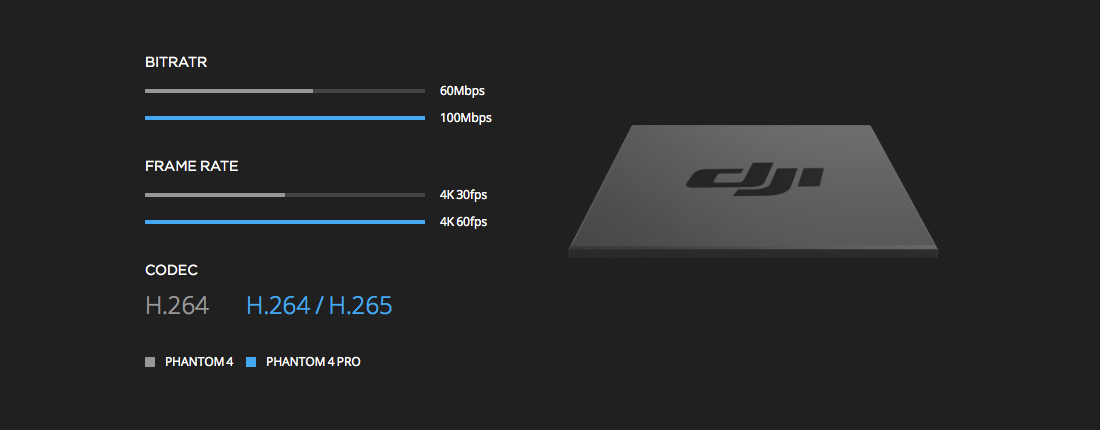
CAPTURE EVERY MOMENT
-
Aerial imaging is not only used to capture landscapes; it brings new perspectives to everything from action scenes to motor racing. Capturing objects moving at high speed has always been a challenge for flying cameras using an electronic shutter. This is why the Phantom 4 Pro is the first DJI Phantom to use a mechanical shutter and a large-aperture prime lens.
-
A mechanical shutter with a max speed of 1/2000s eliminates rolling shutter distortion which can occur when taking images of fast-moving subjects or when flying at high-speed high speed. The electronic shutter has also been improved with a max shutter speed of 1/8000 seconds, and a new Burst Mode shoot capable of shooting 14 fps at 20 megapixels to catch the perfect moment.
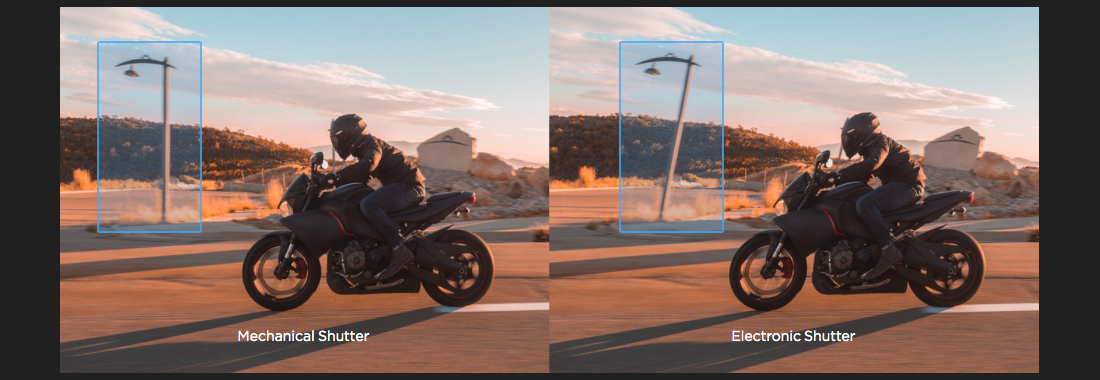
FIVE DIRECTIONS OF OBSTACLE SENSING
-
FlightAutonomy is expanded with an additional set of high-resolution stereo vision sensors placed at the rear in addition to the pair placed at the front as well as infrared sensing systems placed on the left and right sides. This network creates a total of five directions of obstacle sensing and four directions of obstacle avoidance, protecting the Phantom 4 Pro from more obstacles and giving filmmakers the confidence to capture more complex images. 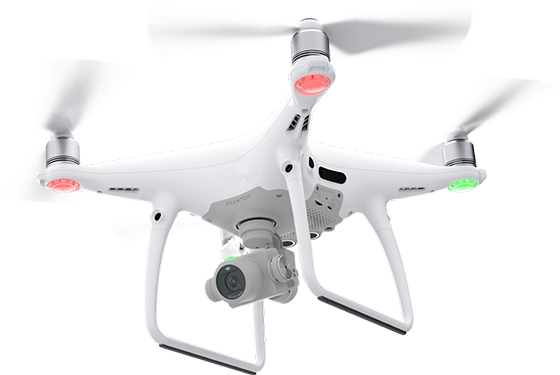
Pilots always need to be aware of obstacles when shooting from the air. This is a challenge for beginner pilots as well as experienced pilots, especially when sight lines are obstructed. The Phantom 4 Pro is equipped with an environment-sensing system based on stereo vision sensors and infrared sensors. It is able to detect obstacles 98ft (30m) in front, allowing it to plan its flight path to avoid them or simply hover in the event of an emergency. This same system also allows it to hover in position without GPS. Combined with infrared sensors on its left and right sides, the Phantom 4 Pro can avoid obstacles in a total of four directions. Forward and rearward obstacle sensing range has been increased, allowing the Phantom 4 Pro to fly at 31mph (50kph) with full protection of its stereo vision obstacle sensing system. It makes fast, dramatic video easier and ultimately safer to capture.
-
SIX-CAMERA NAVIGATION SYSTEM
Three sets of dual vision sensors form a six-camera navigation system that works constantly to calculate the relative speed and distance between the aircraft and an object. Using this network of forwarding, rearward and downward vison sensors, the Phantom 4 Pro is able to hover precisely in places without GPS when taking off indoors, or on balconies, or even when flying through windows with minimal pilot control. In the unlikely event that front and downward sensors are unable to operate, the aircraft can still hover in place using the rear stereo vision system. The Phantom 4 Pro also is able to fly in complex environments at a flight speed of up to 31mph (50kph) while avoiding obstacles in its path. It will automatically adjust its obstacle detection method in line with its flight speed, allowing it to avoid obstacles at high and low speeds.
-
WHAT IS FLIGHT AUTONOMY
FlightAutonomy is an advanced aerial intelligence and flight automation platform. It is made up of a complex network of ten component groups including seven cameras — forward, rearward and downward dual vision sensors and the primary camera — an infrared sensing system, dual-band satellite positioning (GPS and GLONASS), two downward-facing ultrasonic rangefinders, redundant IMUs and compasses, and a group of powerful, specialized computing cores. The Phantom 4 Pro acquires a real-time view of its environment and information about the height and position of nearby obstacles to create a 3D map it can locate itself within. The IMU and compasses collect crucial flight status, speed and direction data, while redundant IMUs and compasses monitor critical data and rule out possible errors, dramatically enhancing the reliability of flight.
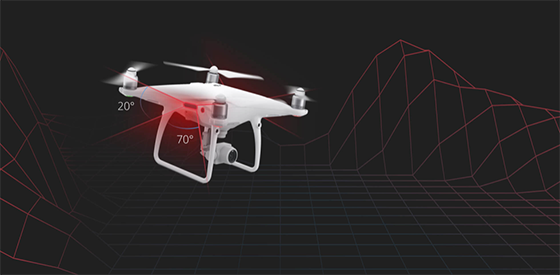
-
INFRARED SENSING SYSTEM
The Phantom 4 Pro is the first DJI aircraft to use an infrared sensing system. Placed on the left, and right sides of the aircraft, these measure the distance between the aircraft and any obstacles using infrared 3D scanning. When in Beginner Mode and Tripod Mode, these sensors have a horizontal field of view of 70° and a vertical field of view of 20°, providing a wide view of the scene to the sides of the Phantom, and a maximum range of 23ft (7m). Traditional ultrasonic sensors only have a detection range of 3-5m and may be confused when affected by propeller vibration or when sensing uneven surfaces. The infrared sensing system is able to sense larger areas and measure the distance between the aircraft, identifying the closest objects accurately while avoiding interference, providing more reliable sensing and protection.
- 25 May 2018






































































